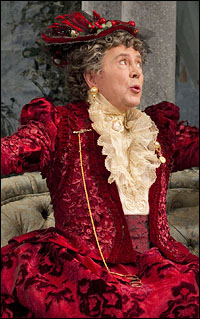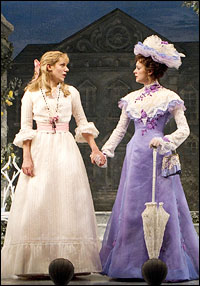
*
When the footlight-kissed, hand-painted show curtain rises on the London drawing room of Roundabout Theatre Company's new production of Oscar Wilde's The Importance of Being Earnest, the audience inevitably applauds. But not necessarily because scenic (and costume) designer Desmond Heeley, 79, has created an ultra-realistic set. It's the painterly, impressionistic, un-literal quality that grabs you (in all three acts). Where another designer might try to create a smooth porcelain vase on a set, Heeley's vase is a slightly uneven one — its artifice is part of its charm in this play about surface. His Act Two garden is punctuated with frosted greenery and artificial flowers. In the distance, on canvas, is a stately home of England. It's not seeking to be photorealism; it wants to be theatrical. (This production first surfaced at Canada's Stratford Festival, and there were only slight scenic changes between then and now; the footlights are new, for example.)
British-born Heeley — whose work has been seen in the worlds of opera, dance and theatre for more than 50 years, La Scala to the Royal National Theatre — spoke to Playbill.com about his processes and passions.
There's this beautiful handmade quality to what you've done in the scenic design of Earnest. Is this very much a Desmond Heeley kind of aesthetic?
Desmond Heeley: Well, it is, actually. I've been accused of being hands-on, hands-on, hands-on, but I grew up in a workroom, and I loved the actual — physical — thing of doing it.
I love the impressionistic quality. There is a painterly quality to it.
DH: Oh, thank you. That's the compliment I was looking for. It's a wonderful chance to make artifice happen, as opposed to just downright realism. It's an attempt to create an atmosphere. In the doing of that, especially in this play, it's appropriate for what it is, being a theatrical device, because they're not real people, really. Also, it's much more fun for an audience, too. I think that the minute you walk in the theatre, especially with this play, that you should have a sense of expectation — [with the] the footlights and the nod towards 19th-century theatre with the show curtain — that you're in a theatre watching a theatrical performance. The show curtain was great fun to paint. That was my last bit of scene-painting on my own [that] I did before my legs started bothering me. [Laughs.]
Literally, you are that hands-on? You are up there painting?
DH: I painted the drop myself, the front cloth, yeah.
I love the hint of gold leaf that you toss in there on the show curtain.
DH: The "gold leaf" is Christmas paper, by the way. It's cheaper and more effective. [Laughs.]
When the light hits it, it almost has a quality of lights embedded in the curtain. Is that Queen Victoria herself on the curtain?
DH: No, that's Britannia. Yes, indeed, with her trident…
And you painted the letters "V.R.," correct?
DH: Yes, Victoria Regina.
| |
 |
|
| Brian Bedford as Lady Bracknell | ||
| photo by Joan Marcus |
DH: Yes, it was a theatrical world with a capital "T." And also, it's a pleasurable one. It's a joyful one, and it's fun. I think it's the reason why I fell into the theatre, because it is the air of make-believe and what used to be called the magic world behind the scenes. I should add that I'm a World War II child, so we had to make do with anything that you had around to make things happen…homely fabrics…masking tape…the ever-loving wire coat hangers. They're cheap, lying around, and you can quickly put them into shape, you can quickly sculpt them. People sometimes see what I do and think, "Oh, God. Sloshy, sloshy." It's not. It's very carefully worked out. That's the illusion of it being impressionistic, the illusion of it being a poem. But the one thing I'm always chasing, sometimes successfully, sometimes not, is air on stage, so that the spaces are as important as the solid bits, you know?
Like the tension between the more defined downstage set and the upstage mansion in the distance?
DH: Yes, indeed. The further away you get, the more misty things get. It's like taking a photograph, when you focus on the performers. So what's above them is slightly out-of-focus, and what's downstage is more muddled, you know? It's like bas-relief, traditional bas-relief. It's a nod towards the more popular arts.
And are there wire hangers on this set?
DH: By the mile, yeah. [Laughs.] They're disguised, they're disguised. It's a good structure. You join two or three of those together and you've got a strong place to work on, and it's also fast, it's cheap, and you can do all sorts of things with it. The chandelier in Act Three is made of plastic wine glasses and plastic plates and plastic flutes and plastic spoons, but the wire — the dry-cleaning wires — are the best [Laughs] because they're the strongest. I know I sound like I'm joking, but you can get an effect of delicacy, and you also have strength.
Up close, it wouldn't look like a chandelier, but from down front or from the balcony, it does. That's the joy of the eye, I guess.
DH: Well, you see, I'm not awfully keen on the audience coming to see how it's made. I like them to sit where they're meant to. [Laughs.]
No backstage tours.
DH: No, distance lends enchantment. It's like a magician, you know. "I've got nothing up my sleeve; watch this."
Was there any pressure to "bump up" the visuals for Broadway since the 2009 Stratford production? Was this stuff put in storage after Stratford and shipped down?
DH: No, no, no, a great deal of it [is new]. Brian's clothes are from Stratford, but the rest of it has been manufactured [in New York]. Some of the trellises were from Stratford, but the whole thing has been built here. [The American Airlines is] a slightly larger theatre [than Stratford's Avon Theatre], too.
| |
 |
|
| Charlotte Parry and Sara Topham in The Importance of Being Earnest | ||
| photo by Joan Marcus |
DH: Oh, that I couldn't! [Laughs.] There's no padding, there's no corset, there's nothing, it's just him.
And is there a challenge creating a costume for a man playing a woman?
DH: It's a delicate one, especially if you've never done it before for them. There's a danger. I mean, a number of men have played Bracknell, and the danger, a real danger, is slipping over into camp. But the marvelous thing about old Brian is that he makes her very truthful and plausible. You really do forget it's a male playing the part, and that's his skill as an actor. But it's a little daunting to begin with, to feel your way in. I do dozens and dozens and dozens of sketches and try this, try that before we ever go forward. What the public never sees is the amount of work we do, designers. I mean, we are the first to begin and we're the last to finish.
The needs of the performer — and I mean this very sincerely — the needs of the performer are paramount in making a good design. I happen to love fittings.
Bracknell is in black in Act One, and red in Act Three.
DH: Yes! [Laughs.] Well, I saw the fabric first of all, and I thought, "Oh, golly! That's — woo! I wonder if, I wonder if." Perhaps [it was] a tad bright, but it was meant to be ruby-ish but something happened and it grew. But I think it happily grew, you know.
I love when clothes indicate character. Mischievous Algernon wears rather bold stripes, which conveys a kind of youth.
DH: Well, the stripes are a university blazer. It's Oxford, you know. He is a bit bolder than normal, but like he says, he has nothing but looks everything. You've taught many students over the years.
DH: I've done lots of lectures and show-and-tells… I can't call it teaching. What I like to call it is raising enthusiasm.
Do you underline the "hand-painted" quality?
DH: Not the hand-painted quality. That can be misleading if you emphasize that. [The focus of my teaching] is to use any skills you have to tell a story. Some people draw beautifully and can put it down. Some people are technically wonderfully equipped to do that sort of thing. Some people are visionaries and poets who need help from the staff. So there's no given way. In teaching, I've always tried to help the student find his or her own voice.
Do you remember your first brush with the theatre? Were you a kid? Did you go to "pantos" in England?
DH: At the age of five, I was taken to see a pantomime, which I think was called Goldilocks and the Three Bears. And for some reason, in it, there was a spooky toy shop, which I thought was rather good at five, but out of this ceiling came this cardboard skeleton dancing about, and I can remember it plainly, and thinking, "That's not very good. It's just an old cardboard thing." But at the same time, in the toy shop, there were these life-sized dolls in boxes, and do you know what? They came alive. I was amazed. These dolls were alive! It was amazing. [Laughs.] Again, the childhood innocence and the fact that the mask and the dolls had stepped out of their boxes was part of this silly pantomime. It was a very small town. It was not a grand theatre at all.
You grew up in the provinces?
DH: Yeah, just outside Stratford-on-Avon, and then Stratford-on-Avon became my home. My debut as a designer was at Stratford-on-Avon. I think I was 17. I was on staff, and they said, "We're going to do Toad at Toad Hall and you're doing the costumes for it." [I said], "Oh! O.K.!" By then, I'd been working there for a year and was a useful pair of hands, and I was cheap.
Are you a visual artist on your own? Do you paint?
DH: No, I do paint, but I'm a theatre guy. I wish I were a real painter; I'm not. I'm a theatre one. There's a great difference, you know.
(Kenneth Jones is managing editor of Playbill.com. Write to him at kjones@playbill.com.)
View highlights from the show:










